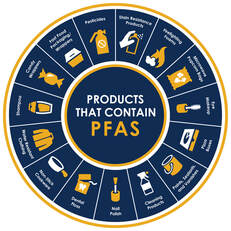|
Humans and animals can be exposed to various toxic chemicals through air, food, and drinking water, causing adverse health effects. PFASs are a group of human-made chemicals that have been widely used in industry and consumer products. Drinking water is identified as a primary pathway of human PFASs exposure around the world, and areas with detectable levels of PFASs in the US are tightly linked to industrial sites. Worthy noted, northern Alabama is one of the most affected areas across the country, due to large quantity of PFASs discharged into the Tennessee River by the 3M Decatur plant in the 1990s.
Click to check an Interactive Map which documents PFAS pollution in public and private water systems in the U.S. www.ewg.org/interactive-maps/pfas_contamination/map/ |
Some chemicals belonging to the PFAS group are shown to have PBT characteristics. P means persistent, all PFASs are very persistent in environmental media. They break down very slowly and can build up in organisms and environment over time. B means bio-accumulative, researchers have found the ubiquitous presence of several PFASs in human blood and serum, with half-lives of up to 5 years. T means toxic, current studies have shown that exposure to certain levels of PFASs may lead to many harmful effects including reproductive effects such as decreased fertility, developmental effects such as low birth weight, increased risk of some cancers and reduced ability of the body’s immune system to fight infections. Due to these PBT properties, the long-chain PFASs have been gradually phased out in the US and replaced by various fluorinated alternatives since 2000. One of the most widely used alternatives is GenX, the toxicity of which was poorly understood.
|
Photos of Monodelphis domestica adult and embryos. (A) Adult LSD strain female. (B) Female with a litter of 10 pups. The newborns are ∼36 h postpartum age. (C) A newborn pup, <12 h postpartum age. Scale is 1 mm between marks (from Samollow et al. 2008).
|
Wang lab used Monodelphis domestica, a laboratory marsupial model maintained at Auburn University College of Veterinary Medicine, to investigate the genetic, epigenetic, and histopathological effects of PFASs exposure. We aim to examine the morphological and histopathological changes as well as gene expression profiles in blood and major tissues after exposure, and finally identify the mechanisms of the adverse effects caused by exposure to PFASs compounds.
Monodelphis domestica were born on embryonic day 14, equivalent to a 5.5 week human embryo and mouse fetus at 11.5 day of gestation, which can be accessed as embryos. Their lung is not developed at birth, with the respiratory function performed through the skin, which increased the exposure of embryos to environmental toxic compounds. These unique characteristics provide significant advantages in early development toxicology research, compared to any other mammalian laboratory animal models. Our research will be the first to establish a Marsupial Model to investigate the effects of environmental toxic compounds, to gain essential knowledge of the potential harm of PFASs on human and other animals. This is important for human health, as well as wildlife and environment protection. Determining potential harms of PFASs can also inform the policy maker to reinforce control of toxic compounds discharge and water resources protection. |


